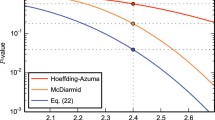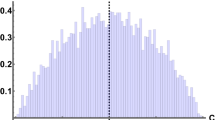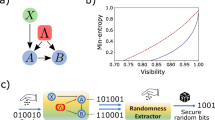Abstract
Nowadays, contextuality is the hottest topic of quantum foundations and, especially, foundations of quantum information theory. This notion is characterized by the huge diversity of approaches and interpretations. One of the strongest trends in contextual research is to identify contextuality with Bell test contextuality (BTC). In this paper, we criticize the BTC approach. It can be compared with an attempt to identify the complex and theoretically nontrivial notion of randomness with a test for randomness (or a batch of tests, as the NIST test). We advertise Bohr contextuality taking into account all experimental conditions (context). In the simplest case, the measurement context of an observable A is reduced to joint measurement with a compatible observable B. The latter definition was originally considered by Bell in relation to his inequality. We call it joint measurement contextuality (JMC). Although JMC is based on the use of counterfactuals, by considering it within the general Bohr’s framework, it is possible to handle JMC on physical grounds. We suggest (similarly to randomness) to certify JMC in experimental data with Bell tests, but only certify and not reduce.
Similar content being viewed by others
References
J. S. Bell, Rev. Mod. Phys., 38, 450 (1966).
J. S. Bell, Speakable and Unspeakable in Quantum Mechanics, 2nd ed., Cambridge University Press (2004).
J. F. Clauser, M. A. Horne, A. Shimony, and R. A. Holt, Phys. Rev. Lett., 23, 880 (1969).
A. Khrennikov, Entropy, 21, 806 (2019).
A. Khrennikov, Entropy, 22, 303 (2020).
A. Khrennikov, Open Phys., 15, 734 (2017).
A. Cabello, S. Severini, and A. Winter, (Non-)contextuality of physical theories as an axiom. ???
M. Araujo, M. T. Quintino, C. Budroni, et al., Phys. Rev. A, 88, 022118 (2013).
E. N. Dzhafarov and J. V. Kujala, “Probabilistic contextuality in EPR/Bohm-type systems with signaling allowed,” in: Contextuality from Quantum Physics to Psychology, WSP, Singapore (2015), p. 287.
E. N. Dzhafarov and J. V. Kujala, J. Math. Psych., 74, 11 (2016).
A. Khrennikov, Int. J. Quantum Inf., 14, 1640009 (2016).
A. Khrennikov, Probability and Randomness: Quantum versus Classical, Imperial College Press, London (2016).
A. Yu. Khrennikov, Interpretations of Probability, VSP Int. Sci. Publishers, Utrecht/Tokyo (1999); 2nd ed., De Gruyter, Berlin (2009).
A. Khrennikov, Phys. Lett. A, 278, 307 (2001).
A. Khrennikov, J. Math. Phys., 44, 2471 (2003).
A. Khrennikov, Europhys. Lett., 69, 678 (2005).
A. Khrennikov, Found. Phys., 35, 1655 (2005).
A. Khrennikov, Entropy, 10, 19 (2008).
A. Khrennikov, Contextual Approach to Quantum Formalism, Springer, Berlin/Heidelberg, Germany; New York, NY, USA (2009).
A. Khrennikov, Open Syst. Inf. Dyn., 23, 1650008 (2016).
A. Khrennikov, “Formalization of Bohr’s contextuality within theory of open quantum systems,” arXiv:2102.09184 [quant-ph].
N. Bohr, The Philosophical Writings of Niels Bohr, Ox Bow Press, Woodbridge, UK (1987).
A. Plotnitsky, Epistemology and Probability: Bohr, Heisenberg, Schr¨odinger and the Nature of Quantum-Theoretical Thinking, Springer, Berlin, Germany; New York, NY, USA (2009).
A. Plotnitsky, Niels Bohr and Complementarity: An Introduction, Springer, Berlin, Germany; New York, NY, USA (2012).
K. Svozil, “Varieties of contextuality based on complexion, quantum probabilities, and structural nonembeddability,” arXiv.org/abs/2103.06110.
A. Shimony, “Hidden-variable models of quantum mechanics (Noncontextual and contextual),” in: Compendium of Quantum Physics, Springer, Berlin/Heidelberg, Germary (2009), pp. 287–291.
A. Shimony, “Experimental test of local hidden variable theories,” in: Foundations of Quantum Mechanics, Academic, New York, NY, USA (1971).
E. G. Beltrametti and C. Cassinelli, SIAM, 25, 429 (1983).
K. Svozil, Phys. Rev. A, 80, 04010 (2009).
R. B. Griffiths, “Quantum nonlocality: Myth and reality,” arXiv:1901.07050.
A. Khrennikov, “Bell argument: Locality or realism? Time to make the choice,” AIP Conf. Proc., 1424, 160 (2012).
A. Khrennikov, “Echoing the recent Google success: Foundational roots of quantum supremacy,” arXiv:1911.10337 [quant-ph].
J. von Neumann, Mathematical Foundations of Quantum Mechanics, Princeton Univ. Press, Princeton, NJ, USA (1955).
A. Khrennikov, Ubiquitous Quantum Structure: from Psychology to Finances, Springer, Berlin-Heidelberg-New York (2010).
J. Busemeyer and P. Bruza, Quantum Models of Cognition and Decision, Cambridge University Press (2012).
E. Haven and A. Khrennikov, (2013). Quantum Social Science, Cambridge University Press (2013).
M. Asano, A. Khrennikov, M. Ohya, et al., Quantum Adaptivity in Biology: from Genetics to Cognition, Springer, Heidelberg-Berlin-New York (2015).
G. Adenier and A. Khrennikov, J. Phys. B: At. Mol. Opt., 40, 131 (2007).
A. Aspect, J. Dalibard, and G. Roger, Phys. Rev. Lett., 49, 1804 (1982).
A. Aspect, Three Experimental Tests of Bell Inequalities by the Measurement of Polarization Correlations between Photons, Orsay, Paris, France (1983).
G. Weihs, T. Jennewein, C. Simon, et al., Phys. Rev. Lett., 81, 5039 (1988).
B. Hensen, H. Bernien, A. Dréau, et al., Nature, 5, 682 (2015).
G. Adenier and A. Y. Khrennikov, Fortschritte der Physik, 65, 1600096 (2016).
E. N. Dzhafarov and J. V. Kujala, “Probabilistic contextuality in EPR/Bohm-type systems with signaling allowed,” in: Contextuality from Quantum Physics to Psychology, WSP, Singapore (2015), p. 287.
A. Khrennikov and A. Alodjants, Entropy, 21, 157 (2019).
A. N. Kolmolgoroff, Grundbegriffe der Wahrscheinlichkeitsrechnung, Springer-Verlag, Berlin (1933).
A. Fine, Phys. Rev. Lett., 48, 291 (1982).
A. Fine, J. Math. Phys., 23, 1306 (1982).
P. Suppes aud M. Zanotti, Synthese, 48, 191 (1981).
R. von Mises, Math. Z., 5, 52 (1919).
R. von Mises, Probability, Statistics and Truth, Macmillan, London (1957).
R. von Mises, The Mathematical Theory of Probability and Statistics, Academic, London (1964).
A. Khrennikov and I. Basieva, Entropy, 20, 280 (2018).
E. R. Loubenets and A. Y. Khrennikov, J. Phys. A: Math. Theor., 52, 435304 (2019).
M. Giustina, M. A. Versteegh, S. Wengerowsky, et al., Phys. Rev. Lett., 1, 250401 (2015).
L. K. Shalm, E. Meyer-Scott, B. G. Christensen, et al., Phys. Rev. Lett., 115, 250402 (2015).
A. Khrennikov, S. Ramelow, R. Ursin, et al., Phys. Scr., 2014 ???, 014019 (2014).
V. Andreev, Acta Physica Hungarica B: Quantum Electron., 26, 213 (2006).
V. A. Andreev, V. I. Man’ko, O. V. Man’ko, and E. V. Shchukin, Theor. Math. Phys., 146, 140 (2006).
V. A. Andreev, Theor. Math. Phys., 152, 1286 (2007).
V. A. Andreev, Theor. Math. Phys., 158, 196 (2009).
Author information
Authors and Affiliations
Corresponding author
Rights and permissions
About this article
Cite this article
Khrennikov, A. Against Identification of Contextuality with Violation of the Bell Inequalities: Lessons from Theory of Randomness. J Russ Laser Res 43, 48–59 (2022). https://doi.org/10.1007/s10946-022-10022-9
Received:
Published:
Issue Date:
DOI: https://doi.org/10.1007/s10946-022-10022-9




